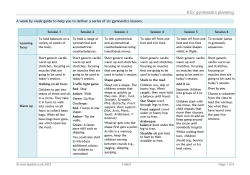Gymnastics lesson plans

A scheme of work to help you deliver a series of six gymnastics lessons aligned to the key stage 2 National Curriculum for PE.
These PE lesson plans focus on a range of gymnastics activities, including holding and linking symmetrical and asymmetrical counterbalances, taking off and landing and creating sequences including jumps.
The lesson plans include ideas for learning objectives, warm-ups, main activities, plenaries, teaching points, success criteria and AfL.
A great starting point to help the non-specialist teacher deliver PE lessons.
A sample lesson:
Learning focus: To link symmetrical and asymmetrical counterbalances using transitional moves.
Warm up:
Short generic cardio warm up and stretches, focusing on muscles that are going to be used in today’s session.
Shape game: Shout out a shape. The children create that shape as quickly as they can. (Star, Tuck, Straight, Straddle, Pike, Butterfly, Front support, Back support, Dish, Arch, Plank, Squat, Arabesque, V balance)
Whoever gets into the shape first gets a point. As this is a warmup game, keep the children moving between rounds e.g., jogging, skipping, jumping.
Main activities:
Children should explore ways of travelling into and out of their counterbalances. E.g.Teddy bear rolls, log rolls and cartwheels.
Using the balances they practised last session, children should now link the balances using fluid transitional ways of travel. Children should also practise holding balances at difference levels - low, medium, and high – hold for four seconds and then move into a different balance at a different level.
Allow time to practise so children can perfect their sequences. Peer evaluation is a great tool to use here.
Teaching points:
Encourage children to use seamless moves between balances.
Talk to children about balances facing different directions and at various levels.
Success criteria:
Children can show symmetrical and asymmetrical balances.
Children can transition smoothly between balances.
Children can work effectively in pairs and groups and provide each other with effective, constructive feedback.
Plenary and AfL:
Cool down: A series of stretches to stretch out muscles used throughout session.
AFL: Question children on why they chose particular transition moves. How did this help/hinder their routine?
